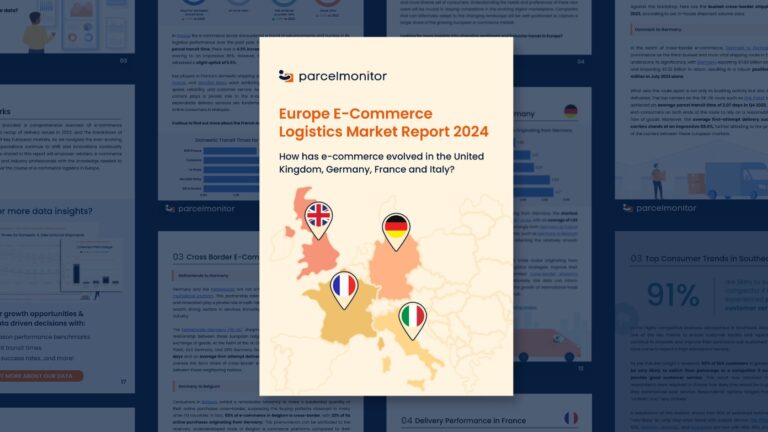E-commerce has grown as a key component of international trade in Europe as well as around the world. With significant developments and breakthroughs in e-commerce logistics and delivery technologies, an increasing number of customers are turning to online markets to meet their demands.
The European e-commerce market has grown dramatically in recent years and its current growth trajectory is projected to continue for the foreseeable future. eCommerceDB estimates that the European e-commerce sector will be valued at US$750bn by 2027.
In this regard, understanding the logistics of e-commerce is crucial for stakeholders and decision makers as the market grows. While the European Union (EU) consists of 27 nations, this report will focus on the e-commerce and delivery performance of three of them – France, Germany and Italy – as well as the UK.
Here’s what you can expect from downloading Parcel Monitor’s full report:
1. E-commerce landscape in Europe
In the past decade, Europe’s e-commerce market has grown significantly, especially during the Covid-19 epidemic. CBRE’s E-Commerce in the Post-Pandemic Era 2023 report shows that the UK, Germany, France, and Italy make up around 62% of total European e-commerce spending. For this reason, this section of Parcel Monitor’s Europe E-Commerce Logistics Market Report 2024 presents a thorough overview of the European e-commerce landscape, diving into each market’s own characteristics and dynamics.
From the well-established e-commerce hubs of the UK and Germany to the quickly growing markets of France and Italy, the report provides insights into market trends such as the change in e-commerce penetration rates in most European markets and growth in the number of business-to-consumer (B2C) e-commerce users over the years. It also analyzes competitive landscapes and new prospects for e-commerce businesses in Europe.
2. Cross-border e-commerce in Europe
Despite a post-Brexit reduction in the number of buyers, Western Europe’s cross-border e-commerce business is expanding as consumers spend more money on products from foreign retailers. Much of the motivation has been driven by Chinese e-commerce behemoths and investments by online marketplaces like Amazon and Zalando. Globalization, improved transportation infrastructure and online marketplaces have also led to this increase in cross-border e-commerce, providing buyers with access to global items and brands. Notably, buyer growth will resume in 2025, creating both an opportunity and a threat for European retailers.
In addition to assessing the broader trends and problems of cross-border e-commerce in Europe, the second section of the report offers practical insights into specific cross-border shipping routes with substantial amounts of business. Using its own shipment statistics, Parcel Monitor’s report identifies the biggest cross-border shipping routes in Europe for 2023, including: Denmark to Germany, Germany to Austria, Czech Republic to Germany, Netherlands to Germany, and more.
3. Breakdown of key delivery performance metrics by country
Efficient logistics and reliable delivery services are essential components of a successful e-commerce business. This section provides a thorough analysis of major delivery performance data in France, Germany, Italy and the UK. It dives into metrics like parcel transit durations, first-attempt delivery success rates, on-time delivery rates and issue ratios to get significant insights into the strengths and shortcomings of each country’s delivery infrastructure.
For example, the e-commerce sector in France saw both gains and challenges in logistical performance over the last year. Despite a slight decrease of 4.4% in domestic parcel transit time, the first-attempt delivery success rate increased by 4.2% to 86%. Meanwhile, the overall issue ratio for domestic shipments recorded an increase by 5.5%. Key players in domestic shipping in France, including Colissimo, La Poste, DPD France and Mondial Relay, are vital for the growth of the e-commerce sector.
Download the full report here.


